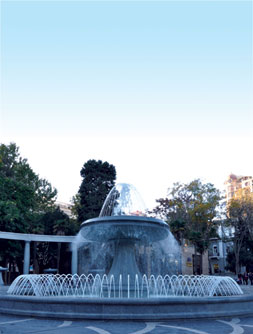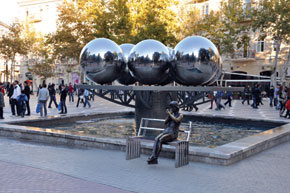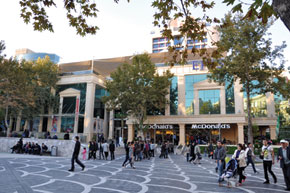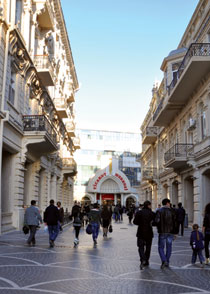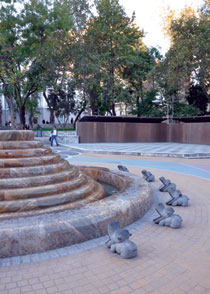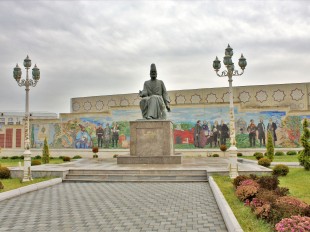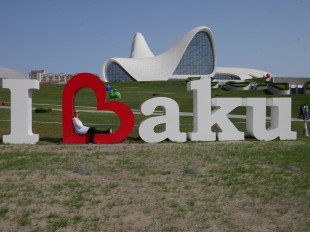Pages 44-47
by Fiona Maclachlan
In Azerbaijan, this former Soviet Union state of 8.7 million people, the people often say proudly that Baku, the capital city, has everything. A unique sea-side city rich in both European and Asian culture and history, Baku boasts a unique and varied architecture - ranging from wide streets with grand mansions with classical Roman and Gothic themes to the UNESCO-protected intimate inner walled city comprising the most ancient and some newer buildings, complete with cobbled streets, narrow alleys and many places of historical interest. For much of the last century, Baku took on a Soviet appearance.
The rapid influx of oil money means that the whole city is now being transformed from Soviet style to, well, what can you call it but "Baku style´. All over the city and beyond, multi-storied buildings are being constructed and old buildings and roads are undergoing renovations. Just two or three years ago, Baku residents and its visitors alike clamoured to look, rather unbelieving, at the illustrations which appeared on sky scraper, city-type, internet websites, depicting what seemed to be highly improbable new buildings . Now many of these futuristic buildings, such as Flame Towers, are nearing completion. Parks and main thoroughfares are having the most lavish updates and in many cases are being completely transformed. Anyone regularly travelling from the airport to the city centre will notice the huge changes taking place. Anyone who hasn´t been here for a while might find much of Baku unrecognisable. A stylish and exciting city is emerging.
Living in Baku through the transformations has been a roller coaster ride of dust one minute and sheer surprise the next.
In the centre, as in any other ancient city, the best and easiest way to get about is to explore on foot.
Fountain Square – old friend, new style
And the principal place to begin exploring is Fountain Square. If it is dining and shopping you´re after, or simply looking to meet up with friends and enjoy the night life, you´ll head to Fountain Square. The chances are that you will return again and again, partly because much of the city centre functions around it, and partly because it´s the place to meet friends, and partly because it´s easy to get to - many roads go round it, though not in a logical fashion.
For many, many months this area, the city´s most used pedestrian thoroughfare and its most popular venue, was under wraps as it was transformed from old to new. We had to walk in dust and debris around the outside of colourful hoardings, while the transformation took place. Nobody seemed to know when the square was going to reopen and it felt a little as if the city had lost its hospitable heart. Because this was our habitual haunt, we suffered without it. We waited with bated breath for the city to come alive again, to feel complete.
Now it´s open again and we can see the transformation that has taken place. Fountain Square must be the envy of many cities. Not many places have this vast pedestrianised space at their heart and, in keeping with the new Baku style, it´s now ultra smart, rather chic, and has not a little wow factor. Perhaps a little like its Baku residents.
It´s the spot to hang out. During the evenings, especially at weekends, the square really comes alive. A parade of fashionably attired Azerbaijani people hit the town and everybody wants to be there. In winter be prepared to be dazzled by New Year lighting displays and the scene of swishing fur atop the highest heeled (but cosy, fur- lined) boots. Baku people must be so proud to be able to enjoy Fountain Square, and to share it with guests to the city.
While the paving, statues, gardens and of course fountains have been renewed, the back drop of the buildings surrounding the square remains largely the same, except that the old buildings have all been renovated and cleaned. Many were built in the 1860s by the famous Azerbaijani architect Hajibababeyov (1811-1874) but my personal favourite, just off the square, is Mikayil Useynov’s facade of the Nizami Museum of Literature where the shiny blue of the tiles is exactly the colour I like best. But look also at the transformed ´passage´, the area we used to call Artists´ Alley; the ceilings under the arches have interesting painted scenes. Not the same as the artists´ alley we used to know and love, but attractive nonetheless.
To see and be seen
Photo opportunities abound, from standing alongside the contemporary bronze statue of a beautiful girl chatting on a mobile phone - expect a queue to do this - to seeing reflections in the mirrored spheres.
The fountains, of course, are beautiful and varied. Most importantly, they work - the old ones seldom did. Don´t we all enjoy the sound of running water, and watching its movement? Baku, incidentally, is exceptionally good at fountains, and could easily call itself a city of fountains. Appropriate then, perhaps, that this important central space is called Fountain Square.
Some of the best views of Fountain Square (it´s not a square by the way) are gained by going up - head for the restaurant terrace at the top of the Nargiz shopping centre. Or alternatively even higher to the bar terrace at the top of the ISR Plaza building. Other views are on the level - simply find yourself a shady seat and watch the city stroll by.
Fountain Square is home to numerous shops, restaurants, cafes and bars. The choice of restaurants is vast, with the Fountain Square area offering everything from McDonald’s to the best of Azerbaijani cuisine. The most interesting is of course the great Azerbaijani cuisine, which is similar to, but more varied than, Turkish food. Lamb kebabs, dolmas, caviar, yogurt soups, so many varieties of salad, to die for tandir bread, plov and tomatoes (the best in the world, many say), as well as the many fresh fruits, will make your mouth water. Baku offers many experiences that provide fond memories for tourists, and the local people are proud and excited as more and more guests arrive. Last year around 1.4 million tourists visited Azerbaijan, more than double the figure in 2002 and a remarkable increase from the 44,934 who came in 1995.
Baku already has all the best ingredients, and yet is investing still more money to ensure its popularity as an international destination in the years to come.
But I would say hurry if you want to see any of the older Baku, the transformation is happening fast. Before long, Baku will have everything except some of the way that it was.
by Fiona Maclachlan
In Azerbaijan, this former Soviet Union state of 8.7 million people, the people often say proudly that Baku, the capital city, has everything. A unique sea-side city rich in both European and Asian culture and history, Baku boasts a unique and varied architecture - ranging from wide streets with grand mansions with classical Roman and Gothic themes to the UNESCO-protected intimate inner walled city comprising the most ancient and some newer buildings, complete with cobbled streets, narrow alleys and many places of historical interest. For much of the last century, Baku took on a Soviet appearance.
The rapid influx of oil money means that the whole city is now being transformed from Soviet style to, well, what can you call it but "Baku style´. All over the city and beyond, multi-storied buildings are being constructed and old buildings and roads are undergoing renovations. Just two or three years ago, Baku residents and its visitors alike clamoured to look, rather unbelieving, at the illustrations which appeared on sky scraper, city-type, internet websites, depicting what seemed to be highly improbable new buildings . Now many of these futuristic buildings, such as Flame Towers, are nearing completion. Parks and main thoroughfares are having the most lavish updates and in many cases are being completely transformed. Anyone regularly travelling from the airport to the city centre will notice the huge changes taking place. Anyone who hasn´t been here for a while might find much of Baku unrecognisable. A stylish and exciting city is emerging.
Living in Baku through the transformations has been a roller coaster ride of dust one minute and sheer surprise the next.
In the centre, as in any other ancient city, the best and easiest way to get about is to explore on foot.
Fountain Square – old friend, new style
And the principal place to begin exploring is Fountain Square. If it is dining and shopping you´re after, or simply looking to meet up with friends and enjoy the night life, you´ll head to Fountain Square. The chances are that you will return again and again, partly because much of the city centre functions around it, and partly because it´s the place to meet friends, and partly because it´s easy to get to - many roads go round it, though not in a logical fashion.
For many, many months this area, the city´s most used pedestrian thoroughfare and its most popular venue, was under wraps as it was transformed from old to new. We had to walk in dust and debris around the outside of colourful hoardings, while the transformation took place. Nobody seemed to know when the square was going to reopen and it felt a little as if the city had lost its hospitable heart. Because this was our habitual haunt, we suffered without it. We waited with bated breath for the city to come alive again, to feel complete.
Now it´s open again and we can see the transformation that has taken place. Fountain Square must be the envy of many cities. Not many places have this vast pedestrianised space at their heart and, in keeping with the new Baku style, it´s now ultra smart, rather chic, and has not a little wow factor. Perhaps a little like its Baku residents.
It´s the spot to hang out. During the evenings, especially at weekends, the square really comes alive. A parade of fashionably attired Azerbaijani people hit the town and everybody wants to be there. In winter be prepared to be dazzled by New Year lighting displays and the scene of swishing fur atop the highest heeled (but cosy, fur- lined) boots. Baku people must be so proud to be able to enjoy Fountain Square, and to share it with guests to the city.
While the paving, statues, gardens and of course fountains have been renewed, the back drop of the buildings surrounding the square remains largely the same, except that the old buildings have all been renovated and cleaned. Many were built in the 1860s by the famous Azerbaijani architect Hajibababeyov (1811-1874) but my personal favourite, just off the square, is Mikayil Useynov’s facade of the Nizami Museum of Literature where the shiny blue of the tiles is exactly the colour I like best. But look also at the transformed ´passage´, the area we used to call Artists´ Alley; the ceilings under the arches have interesting painted scenes. Not the same as the artists´ alley we used to know and love, but attractive nonetheless.
To see and be seen
Photo opportunities abound, from standing alongside the contemporary bronze statue of a beautiful girl chatting on a mobile phone - expect a queue to do this - to seeing reflections in the mirrored spheres.
The fountains, of course, are beautiful and varied. Most importantly, they work - the old ones seldom did. Don´t we all enjoy the sound of running water, and watching its movement? Baku, incidentally, is exceptionally good at fountains, and could easily call itself a city of fountains. Appropriate then, perhaps, that this important central space is called Fountain Square.
Some of the best views of Fountain Square (it´s not a square by the way) are gained by going up - head for the restaurant terrace at the top of the Nargiz shopping centre. Or alternatively even higher to the bar terrace at the top of the ISR Plaza building. Other views are on the level - simply find yourself a shady seat and watch the city stroll by.
Fountain Square is home to numerous shops, restaurants, cafes and bars. The choice of restaurants is vast, with the Fountain Square area offering everything from McDonald’s to the best of Azerbaijani cuisine. The most interesting is of course the great Azerbaijani cuisine, which is similar to, but more varied than, Turkish food. Lamb kebabs, dolmas, caviar, yogurt soups, so many varieties of salad, to die for tandir bread, plov and tomatoes (the best in the world, many say), as well as the many fresh fruits, will make your mouth water. Baku offers many experiences that provide fond memories for tourists, and the local people are proud and excited as more and more guests arrive. Last year around 1.4 million tourists visited Azerbaijan, more than double the figure in 2002 and a remarkable increase from the 44,934 who came in 1995.
Baku already has all the best ingredients, and yet is investing still more money to ensure its popularity as an international destination in the years to come.
But I would say hurry if you want to see any of the older Baku, the transformation is happening fast. Before long, Baku will have everything except some of the way that it was.
